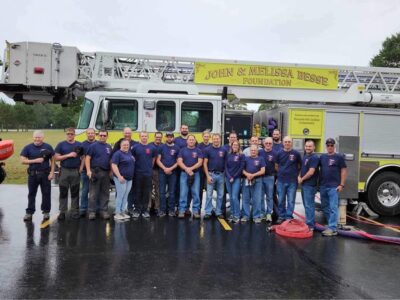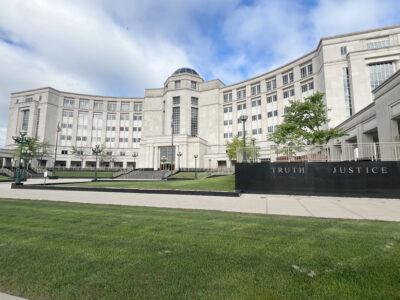Forestry program a tool for landowners

Courtesy photo Natural Resources Conservation Service (NRCS) Soil Conservationist Daniel Blair, Delta Conservation District Forester Ben Marchant and NRCS Soil Conservationist Katie Mumford hike through the snow on a mission to understand objectives for a certain piece of forest and connect the property owner with programs to develop a land management plan.
ESCANABA — Local landowners who intend to harvest their wooded property can make connections with foresters who will help them formulate the best plan for moving forward.
In the Michigan Forestry Assistance Program (FAP), which is grant-funded through Michigan Department of Agriculture and Rural Development (MDARD), district foresters with local conservation districts provide free services such as site visits, referrals to private sector professionals, guidance to navigating other state and federal programs, and other resources.
“We basically provide tools to ensure the landowners can maintain a healthy and sustainable balance with their forest,” said District Forester Benjamin Marchant, who works with the Delta Conservation District. “We do that through multiple programs that we offer with the conservation district, or else the NRCS (Natural Resources Conservation Service).”
One aim is to help promote overall forest health. With about 19 million acres of timberland in the state, optimized management of those parcels can benefit the landowners, numerous wildlife species, and the climate. A survey conducted by Michigan State University showed that only 20% of forest land owned by individuals and families is actively managed.
“A lot of people have the mindset of, ‘oh, let nature do its thing,'” Marchant said. “But then you run this risk of having increased risks of wildfires. And out here we have a lot of stuff called glossy buckthorn ” if you let that go, it goes real fast.”Since aspen is often clear-cut, he said, and the highly-invasive buckthorn explodes easily with sunlight, taking down aspen without managing the understory can lead to the buckthorn outcompeting tree regrowth.
But the point of the FAP isn‚’t to tell property owners what to do with their land. Rather, an FAP forester‚a s job is to listen to the goals of a landowner and act as a liaison to connect them to the right parties to help them achieve their objectives.
Marchant works in Delta and Schoolcraft Counties, and takes calls from private citizens requesting site visits all over the area.
In just four months on the job, “I’ve had landowners from Rock all the way to Seney reach out for assistance,” Marchant said. “A lot of the folks we give assistance to live on the Stonington Peninsula, but we’ll go anywhere in the counties.”
After first contact is made by a landowner, the next step is to draft a forest management plan.
“We post the land’s general description a general location, acreage, forest type along with the landowner’s objectives to our website, and from there, local consulting foresters can bid on the project,‚
Marchant explained. ‚ÄúUltimately, it’s up to the landowner to choose the forester they think is the best fit for their property.
“…Another route we offer, if the landowner doesn’t want to or can’t afford to pay for a plan, is the NRCS EQIP (Environmental Quality Incentives Program). This is a cost share program that covers the cost of a management plan and many of the foresters in the area don’t expect to be paid by the landowner until they are paid through EQIP for the plan. Generally, it comes to a net loss of zero for the landowner.”
To inquire about the program, Delta and Schoolcraft County property owners may contact Marchant at 906-553-7700 ext. 103. In other parts of the state, people can find their district forester by visiting the Michigan Association of Conservation Districts website at macd.org.





